Gravity is the force that pulls objects towards each other and pulls everything towards the center of the Earth. It is an invisible force. This lesson, Gravity for Kids, teaches you all about this significant pulling force, gravity.
It took you quite a while to learn to walk when you were young, but now you do not have any difficulty in walking.
However, do you think that ‘walking’ is only possible due to the learning you got when you were small?
No. There are unseen supporters in the nature that help you walking. ??!!!
No matter how much training you got in walking, without these unseen supporters walking would have been a daydream for you. ???!!!
Not only walking, but also just standing on the ground would be really impossible without theses unseen supporters. ????!!!
Now, who are these supporters that help you to walk?
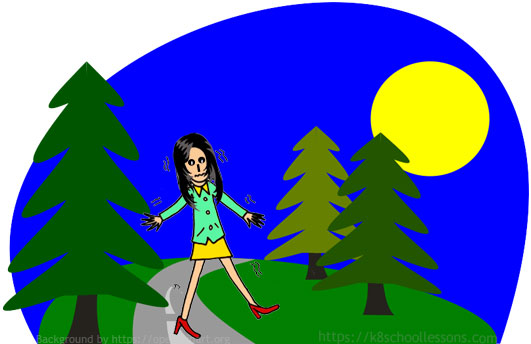 Without gravity and friction it would be impossible to walk or stand on the ground
Without gravity and friction it would be impossible to walk or stand on the ground
Gravity and friction are obvious kinds of forces on Earth that applied on you when you walk and make it easier for you to walk.
In this lesson we are going to learn all what you should know about gravity. Click the link below to read and learn about ‘Friction’.
Read the lesson; Friction
What is gravity? Let’s find the answer for this with the lesson, Gravity for kids.
Gravity is the force that pulls everything towards the center of the Earth.
What goes up must come down, because of gravity.
So, now you’ve found the answer for, ‘what is gravity?’. Next, let’s see what does gravity do with Gravity for kids lesson.
Thanks to gravity;
This is because gravity constantly pulls you toward the ground.
The following Gravity for kids lesson’s diagram shows you how does gravity work on the things on earth and how they are pulled towards the centre of the earth.
 Earth’s gravity constantly pulls you toward the ground
Earth’s gravity constantly pulls you toward the ground
No matter how hard you jump, gravity will always cause you to fall back to the ground.
Look at the following Gravity for kids lesson’s diagram. No matter how hard the girl tries to stay up, she quickly falls back.
 Thanks to gravity, what goes up must come down
Thanks to gravity, what goes up must come down
Without gravity, you could jump into the air and keep moving into outer space!
The following Gravity for kids lesson’s diagram shows you how everything would be floating here and there without gravity.
 Without gravity everything would be floating here and there
Without gravity everything would be floating here and there
Remember the story of Sir Isaac Newton???
Sir Isaac Newton was an English physicist, mathematician and scientist, who was well-known as the founder of gravity.
 Sir Isaac Newton
Sir Isaac Newton
The young Isaac Newton is sitting in his garden when an apple falls on his head. It is said that at this time, he was thinking why did this apple fall, instead of going up. Based on this, he did many studies to find out why things stay on the ground rather than going upwards or floating all over the place. This is how he found out the force of gravity.
 Gravity constantly pulls things toward the ground
Gravity constantly pulls things toward the ground
He realized that the force of gravity, which makes objects fall to the ground, is the same force that keeps the Moon orbiting Earth and the planets orbiting the Sun.
Sir Isaac Newton is not only famous for his law of gravitation, but also his three laws of motion which form the basic principles of modern physics. The unit of force, the newton, was named after him. He made many more important discoveries. He investigated light and invented a new system of mathematics, called calculus.
Gravity is everywhere. It is intangible. You cannot see it either. It is a force of attraction that exists between objects and the Earth. It works in water, on land and in the air.
Gravity is not just the attraction between objects and the Earth. It is an attraction that exists between all objects, everywhere in the universe.
Gravity pulls on all objects, big and small.
For example;
Earth’s gravity pulls the Moon, while the Moon’s gravity pulls Earth.
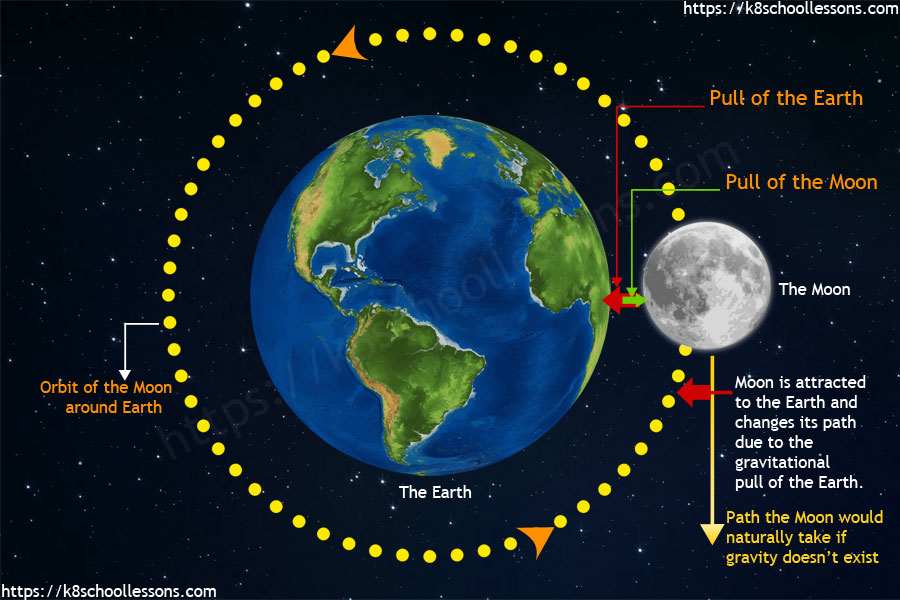 Gravitational pulls of the Earth and the Moon
Gravitational pulls of the Earth and the Moon
Your body has gravity too. ???!!! It pulls Earth toward you, while Earth pulls you toward it. Just like a game of tug of war. Earth is trillions of times heavier than you. So, there’s no way you could win a tug of war with Earth.
If you want to escape from the force of gravity, you definitely have to go a long way away from Earth. The astronauts who have gone to the space are the ones who have escaped the pull of Earth’s gravity. In space or on the Moon you weigh nothing, but just float.
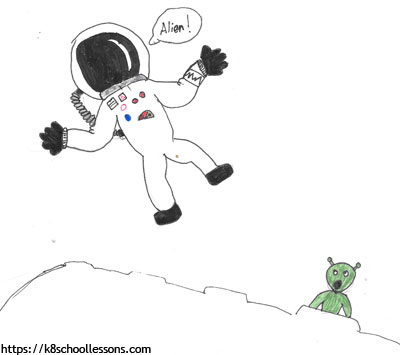 Astronauts who have gone to the space are the ones who have escaped the pull of Earth’s gravity
Astronauts who have gone to the space are the ones who have escaped the pull of Earth’s gravity
However, every large or heavy object in space has gravity. The largest or the heaviest objects have the strongest pull.
“Larger or heavier the object stronger the pull (gravity). Smaller or lighter the object weaker the pull (gravity).”
This means a heavy object is being pulled strongly towards the centre of the Earth. A light object is not being pulled so strongly.
 Larger or heavier the object stronger the pull of gravity. Smaller or lighter the object weaker the pull of gravity.
Larger or heavier the object stronger the pull of gravity. Smaller or lighter the object weaker the pull of gravity.
However, things which are the same size do not always the same.
For example;
A football is lighter than a watermelon of about the same size. So, the watermelon is being pulled strongly towards the centre of the Earth than the football.
If gravity acts on all objects on Earth, how does a feather float and take a long time to fall???
The answer for this question is very simple.
You know, heavier the object stronger the pull of gravity OR lighter the object weaker the pull of gravity.
Based on this, you can understand that the gravity acting on the feather is too weak to pull it towards the centre of the earth. This makes the feather float and fall slowly.
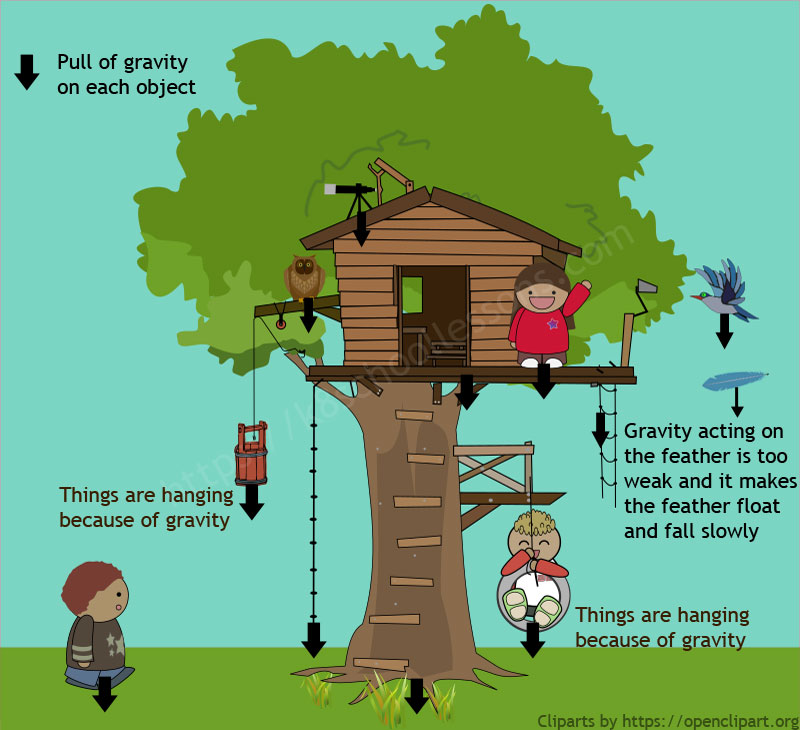 Gravity acting on the feather is too weak and it makes the feather float and fall slowly
Gravity acting on the feather is too weak and it makes the feather float and fall slowly
Also, when a feather falls, it falls slowly because the air is in its way. There is a lot of air resistance and that resistance makes the feather move slower.
Similarly, leaves fallen off trees float in air for sometime before their landing.
If you dropped a feather and a golf ball at the same time in a vacuum (space with no air), the feather would drop as fast as the golf ball.
Therefore, air resistance is more powerful on light objects than gravity, causing them to float a long time before landing.
The Earth is larger than the Moon. Gravity on Earth is stronger than on the Moon. If you reach the Moon, you then feel the pull of the Moon’s gravity which is weaker. Therefore, you weigh nothing on the Moon and just float.
 Weight on Earth vs Moon
Weight on Earth vs Moon
Example;
An astronaut in a space suit weighs 135 kg on Earth, whereas he weighs 22 kg on the Moon. ??!!!
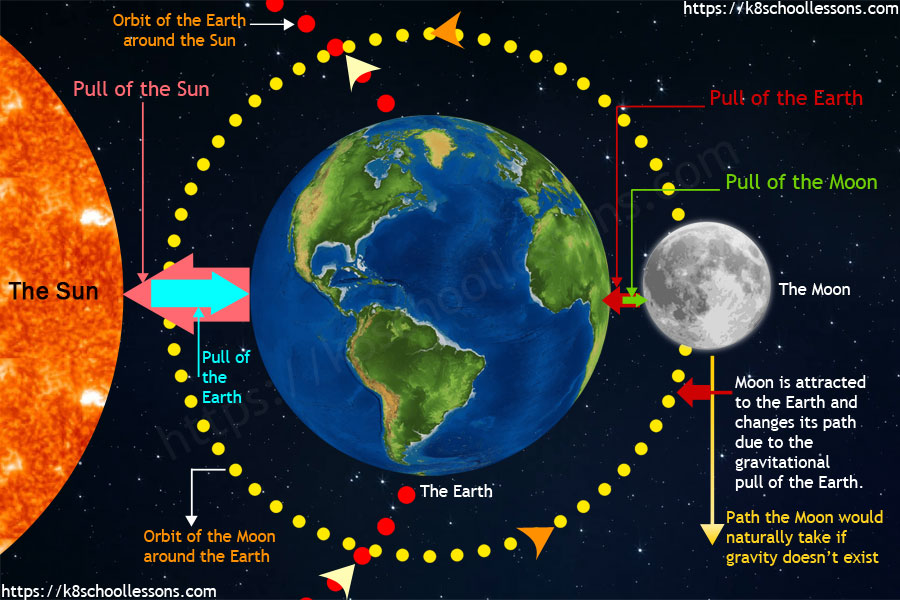 Gravitational pulls of Sun, Earth and Moon
Gravitational pulls of Sun, Earth and Moon
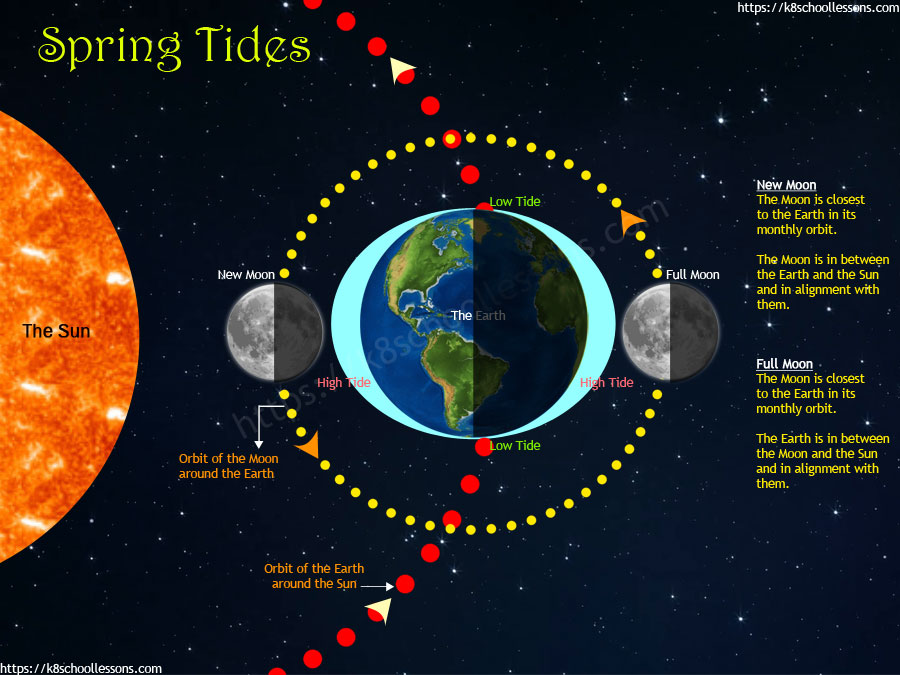 How spring tides occur?
How spring tides occur?
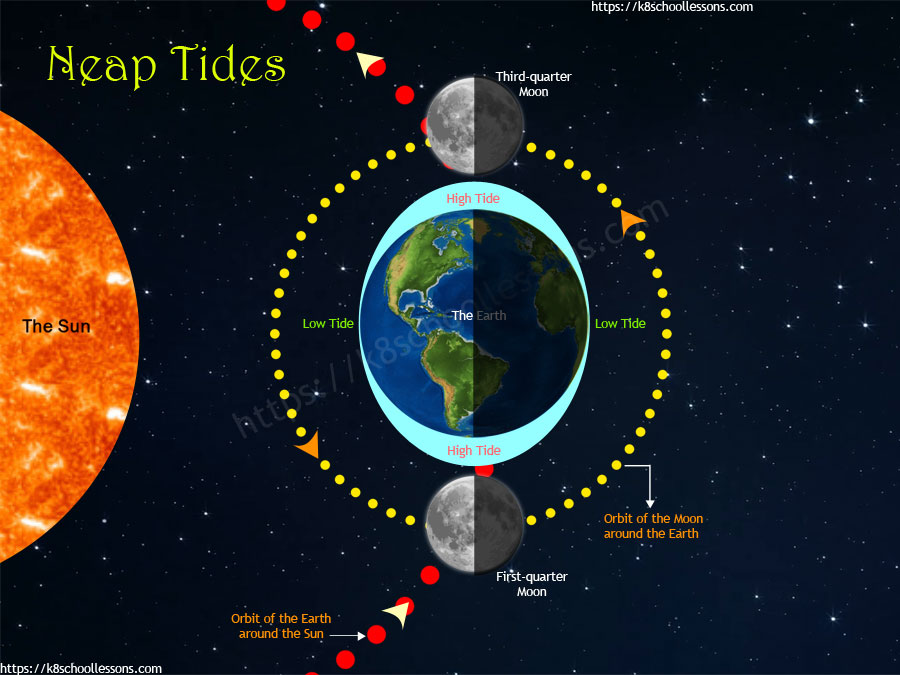 How neap tides occur?
How neap tides occur?
The word weight is very familiar to you. We learn about weight in maths. We use grams and kilograms to measure weight of different objects in our day to day life. May be, many of your relatives and friends are working out to put down their weight through dieting or exercise. Even, you might have seen the weights that lose weight. ???
But, through all these activities we do NOT actually measure or try to lose weight. It is actually mass that we measure in objects and try to lose in our body by dieting and exercise.
 Weight Lifting
Weight Lifting
The quantity of matter in an object is called mass.
In general life people use the word ‘weight’, instead of the word ‘mass’ to tell the amount of matter in an object. By measuring the weight of an object we measure the amount of matter in the object, which is actually the mass of the object, but not the weight. This is why grams (g) and kilograms (kg) are the units of mass, not the units of weight.
The weight of an object is, together the mass of the object and the force of gravity that acts on the object.
Your weight measures the pull of gravity.
Unlike mass, your weight can vary depending on where you are in the universe.
Your mass will not vary on the Moon, but your weight will. This is because, the gravity on the Moon is weaker than on Earth.
The unit of weight is that of force, is the newton.